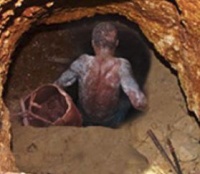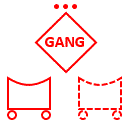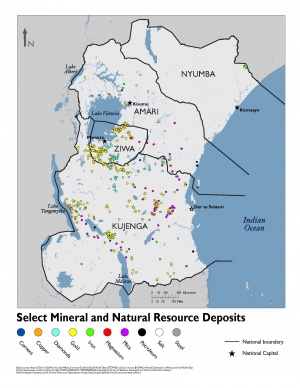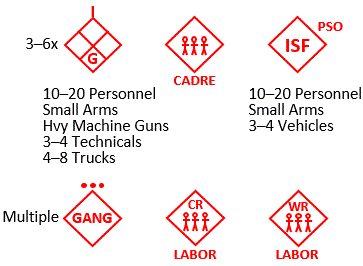Illicit Mining Operations
Illegal mining operations are present in almost all potential OEs, but more so in areas experiencing severe economic or stability challenges. These mines are often former commercial operations that were abandoned due to poor production or extremely hazardous conditions. Gangs, militias, and organized criminal groups lay claim to these sites in order to scrape out what gold, gems, or mineral deposits remain. These groups can be extremely territorial and have demonstrated a propensity for indiscriminate brutality and rapid hostility escalation. Criminal syndicates have collaborated with illegal mine operators or have seized control of the mines for themselves. Some operations have been taken over or are supported by foreign nationals.
The illicit operations may also fuel ancillary criminal activities, such as the trafficking of drugs and weapons, money laundering, human trafficking, and increased local governmental corruption. The violence and related turmoil create waves of internally displaced persons that wash across the region, creating additional pressure on local economies. The mining operations may, in fact, be the instigating cause of more widespread security problems, leading to uprisings in areas far from the actual operations.
Operational Segmentation
The organizational specifics of these illegal mining operations vary greatly, but their operations can be divided into distinct segments to facilitate understanding of potential threats related to military operations. Broadly described, these segments are labor acquisition, illicit mining sites, and commodity smuggling. Each may have unique locations, force structures, and response profiles.
Labor Acquisition
While some of the illicit mines are loose collections of individuals scraping out a living, others are highly organized criminal ventures. In the latter case, the criminal leadership will likely use labor acquired from a variety of sources. Dangerous conditions in the mines and the operators’ brutality make casualty rates high, leading to an ever-present need for more labor.Miners may be desperate people from nearby villages or illegal immigrants seeking wealth. These "Zama Zamas" may be, or be aided by, former mine employees. Even if they start working in the mines for the money, they may become enslaved and forced to continue working against their will. These miners will usually come from areas with rampant unemployment or socio-economic problems.
Many miners are acquired by force. Gangs will conduct violent raids on farms and villages to kidnap potential laborers. In urban environments, gangs often prey upon homeless or other vulnerable populations. Gang and militia violence is extremely vicious, as laborers are also stolen from other mines. Street gunfights and nighttime gunfire is common in the areas near these illicit mines. Migrants may also be vulnerable to kidnapping: If a transport middleman is not paid enough, he may sell the travelers as slaves to the mines. Modern slave markets of kidnapped labor have been reported in urban street markets.
Private prisons have also been a source of illicit labor for mining operations. Prisoners may be held for a variety of dubious charges until a ransom/bail has been paid. These private institutions may directly sell or rent prisoners to work in the mines, and laborers frequently die once sent to client worksites. The prisons are usually as remote as the mines and often hire private security companies to provide internal security and facility defense.
Military forces involved in operations near these mines may encounter gangs or militias that would view their presence as a threat and respond violently. In rural or outlying areas, these groups may be up to platoon-sized elements with small arms and improvised hand weapons; they may also have small trucks or vans. In urban areas, there may be a safe house or other sanctuary to collect kidnapped victims until they can be moved to a mine. Incidental contact with these groups and their victims in transit may also elicit violent reactions.
Illicit Mining Sites
The actual production sites of the illicit mining operations may range in size from small artisanal worksites to sophisticated large-scale operations. While the sites will likely be located off main roads, military units or security forces operating in areas near a site could encounter associated security, refinement, and smuggling elements.
The mining sites are usually a grouping of mining worksites and support buildings. These buildings could include support buildings for cadre and worker barracks, refining sheds, security elements, and various administrative or support functions. The mechanics of the operation are less important than potential actors that will defend it from external forces. These can be divided into forces at the actual site and those in the immediate vicinity.
The cadre at the worksite may consist of a hybrid grouping of organized criminals, guerrillas, militia, and even private security forces. The ratio of which types are present can vary greatly. Their focus is divided between managing site operations and ensuring their continued security and freedom of movement. Internal operations security is tight and punishments for perceived violations are harsh, even deadly. If attacked, these forces will fiercely defend the operation with a mix of small arms and improvised weapons. Private security or guerrilla forces may possess heavier weapons mounted on trucks ("Technicals") in conjunction with improvised defensive positions.
Guard posts and patrols are common near the mining sites. These early warning and protection forces will be a mix of local gangs, guerrilla elements, or contracted private security forces. They will likely have small arms and possibly light machine guns. Handheld radios may be used to alert heavily armed reaction forces. Difficult-to-patrol or sparsely patrolled areas will likely have antipersonnel mines or booby traps. Platoon-sized guerrilla or militia elements will be in the vicinity of the mining site to ensure territorial control and could be used to respond to external threats.
Because of the range of loyalties and fighting quality of the laborers, their responses are more difficult to predict. Those that came to the mines seeking wealth are more likely to defend their meager employment with mining implements or improvised weapons. Forced laborers, if allow to defend the site at all, may respond with improvised weapons or be used as human shields.
Commodity Smuggling
Military units or security forces operating in areas near illicit mining will likely encounter armed and escorted commodity smugglers. The nature of the commodity will determine the size and detectability of the transport. Bulk minerals may be transported in convoys of trucks and smuggled out of country through sea ports. Precious gems and gold can be smuggled in cars and out of the country via individuals ("mules") on commercial aircraft. These individuals may be either voluntary or coerced. Convoys will be guarded by squad-sized guerrilla or militia forces with small arms and possibly technicals with light machine guns. Individual smugglers may be armed and have visible or covert armed escorts for their protection and to ensure the product reaches its destination.




